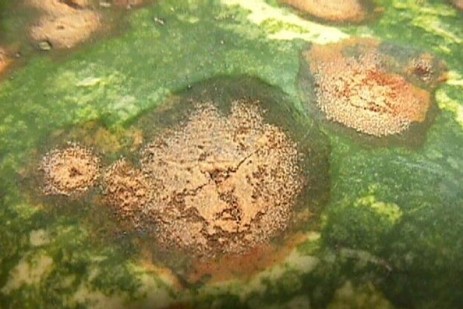I’ve seen alternaria and anthracnose on melons so far this season, and have also had some calls with a concern about gummy stem blight. Here’s what to look for to tell the different diseases apart.
Alternaria leaf spot
Alternaria leaf spot is a common fungal disease of many fruit and vegetable crops, and melons are no exception. Cantaloupes are most often affected, but other cucurbits may be affected as well. Defoliation may occur as the disease progresses, causing reduced yield, sunscald of fruit, and premature ripening. Lesions begin as small, brown spots and enlarge quickly. Enlarged spots may be watersoaked in appearance with a yellow margin. They may have light/dark brown concentric rings, giving them a target-like appearance. Conidia are widely present in the environment and easily spread by wind, so protectant sprays of chlorothalonil or mancozeb are recommended when vines start to run.

Alternaria leaf blight (Alternaria cucumerina) on cantaloupe. Foliar lesion with concentric circles. Photo: Gerald Holmes, California Polytechnic State University at San Luis Obispo (bugwood.org)
Anthracnose
Anthracnose is another common fungal disease that affects several cucurbit crops, including melons. At this time in the season, you’re likely to see lesions on leaves and stems. Look for watersoaked yellowing spots on leaves that rapidly expand to brown or black spots. The centers may tear giving leaves a ragged appearance. Lesions may coalesce, and entire leaves may die. Stem lesions are elongate and sunken and may crack along the center as they age. Young fruit with infected pedicels may die. Older fruit may develop sunken, circular lesions that progress to black as the lesions age. You may see a salmon-colored slime on lesions in wet weather, which is caused by fungal sporulation. Resistant cucurbit varieties are available, and their use is strongly encouraged. There are many fungicides available for anthracnose management, but alternating chlorothalonil with a tank mix of thiophanate-methyl and chlorothalonil or mancozeb is encouraged when disease pressure is low.

Anthracnose (Colletotrichum orbiculare) on watermelon. Note the cracking of necrotic tissue, irregular lesion margins, and shot-hole effect.
Photo: Gerald Holmes, California Polytechnic State University at San Luis Obispo (bugwood.org)
Gummy stem blight
When a grower calls me concerned about a disease issue on a cucurbit crop, this is the disease they most often think they’re dealing with. In all likelihood, it isn’t gummy stem blight, as this disease is much more common further south. That doesn’t mean we don’t get it in Pennsylvania though. On seedlings, look for circular brown watersoaked lesions on the stem and cotyledons. Stems may develop watersoaked brown lesions that split and exude brown to black “gummy” droplets. As these lesions dry, they may turn brown and split further. Fruit lesions start out circular, with a greasy green-brown appearance. Lesions may coalesce and turn black with a sunken appearance, and gummy exudate is possible. If you look closely, you may see very small black dots, called pycnidia, on lesions. The stem lesions, in particular, may appear similar to anthracnose lesions, and the appearance of pycnidia can help tell them apart. Chlorothalonil sprays are advised under low disease pressure; there are other fungicides recommended as a tank mix with chlorothalonil under higher pressure. Resistance is a problem with gummy stem blight, so making solo applications of fungicides in the FRAC Code 11 (Cabrio, Quadris, Flint) isn’t recommended.

Gummy stem blight (vine decline) (Stagonosporopsis cucurbitacearum) on watermelon. Stems show dark, water-soaked lesions often containing black, “pimple-like” fruiting structures. Photo: David B. Langston, University of Georgia (bugwood.org)
– Carla Burkle, Penn State Extension educator

















